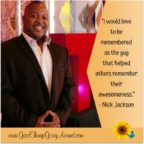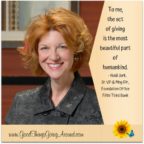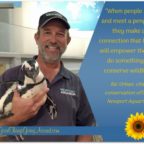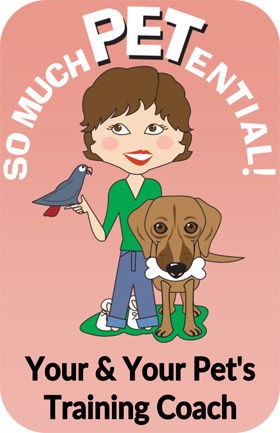CINspirational People
Nick Champions Lives
Today I wanted to introduce you to someone who has championed the lives of more than 265,000 high school and college students. Nick Jackson commands the stage. When he gets in front of audiences he lifts them to a higher place, gets them excited and inspired. It truly is a gift and he has dedicated his adult life to sharing that gift with as many people as he can.
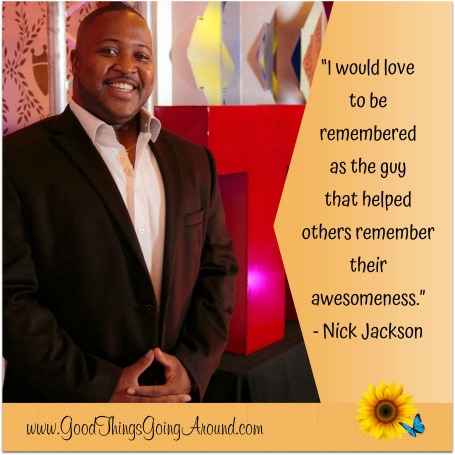 Nick is the first African-American male teacher and coach at Norwood High School in Cincinnati, later going to Ft Thomas Independent School District in Northern Kentucky. If you know him, it would come as no surprise to learn he coached two football teams to state championships, ever once having a losing season. Shortly after, he was selected by NBC, Showtime and Fox Sports’ Cris Collinsworth to become the national spokesperson for a nonprofit called UGive.org. Today, through Nick’s organization – NickJacksonSpeaks.com – he gives transformational speeches to packed events.
Nick is the first African-American male teacher and coach at Norwood High School in Cincinnati, later going to Ft Thomas Independent School District in Northern Kentucky. If you know him, it would come as no surprise to learn he coached two football teams to state championships, ever once having a losing season. Shortly after, he was selected by NBC, Showtime and Fox Sports’ Cris Collinsworth to become the national spokesperson for a nonprofit called UGive.org. Today, through Nick’s organization – NickJacksonSpeaks.com – he gives transformational speeches to packed events.
Let’s learn more about him.
Lisa: You have devoted your adult life and career to inspiring and empowering people. Where does your inspiration draw from?
Nick: My inspiration comes from inside me. Deep, deep inside me there is a young child that was told that the world doesn’t change nor care about you. The best you’ll be able to do is to “fit in it!”
Lisa: Was there a young experience that influenced your life?
Nick: Absolutely, my grandparents are phenomenal. Every time we spoke (they’ve passed) there was another reason to walk away from the conversation uplifted. They had this ability in my life to convey a message of love and empowerment at the same time. I’d walk into their conversations feeling beat down by struggling with an ability difference and the frustration of the day. They would always remind me of the big picture. And in doing this they would remind me that I’m a big part of this bigger picture.
So – keep fighting the good fight.
Lisa: What has driven you to this mission?
Nick: My biggest driving force is the amount of people out there that don’t have positive role models, parents or grandparents that point them in this positive direction.
Lisa: Who is someone that is a role model to you and why.
Nick: My grandfather. I mean he was just awesome! He had a way to connect that was as much spiritual as it was physical. He had a way of making you believe that you are special, and the outcome of your awesomeness opens doors for others to also be awesome!
Lisa: When others think about or remember you, how would you like to be remembered?
Nick: I would love to be remembered as the guy that helped others remember their awesomeness. I’d love to be remembered as the coach that was coaching people in life and the man that gave to them without expectation of return.
Lisa: What is something about you that people may be surprised to learn?
Nick: I have a serious fear of squirrels they freak me out!
Lisa: Do you have any stories of how one of your talks made an impact on your audience and yourself?
Nick: Wow where to start –
The two that come to mind are ones that are very close to my heart. I remember when I first started speaking I was at an elementary school called Crosby Elementary. I spoke to the students about never giving up no matter what other people say your disability is and also knowing that your ability will never be given to you by man. A young man stood up in the back of the room. He was leaning against the wall and he said he was a person with a disability. He explained after hearing our speech how he wouldn’t let other people’s thoughts of his ability hold him down – it was beautiful.
The next story is very similar. We were able to speak at a convention in Texas before thousands of students were with multiple races represented. As I stood there, I noticed that the Latino students, the African-American students and the Caucasian students all sat in separate sections of the auditorium. During the speech we talked about being one, having one voice, and being forgiven together in unison. The crowd of many colors, faiths and backgrounds came together as one in the hallway and we as one took the best selfies ever!

How A Dinner Changed Her Life
Margaret Kastner and I met at a meeting of the Cincinnati Blogger Network many months ago, and she has become one of my Good Things Going Around followers. We have kept in touch and talk when we see each other. She has always struck me as someone very easy to talk to, a kind and uplifting person. I am so glad I asked her for her story, as it gave me an opportunity to get to know an important part of her…and share it with you.
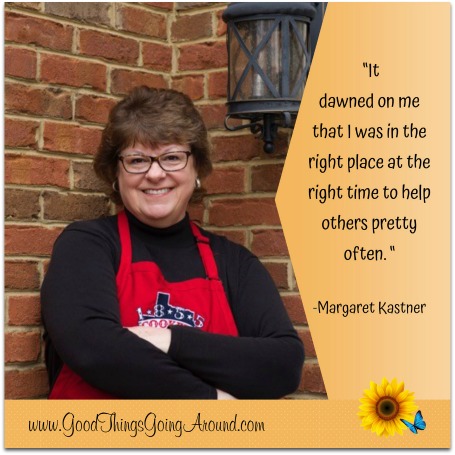 Originally from Detroit, Margaret came to Cincinnati in 1985 with her daughter and fiancé to put down new roots and begin a career with Procter & Gamble (P&G). By 2012 she was ready to do something very different. She retired and began designing and making beautiful sterling silver jewelry. She also started an online business called The Brooch & Bangle which specializes in one of a kind, handmade jewelry that uses a variety of gemstones.
Originally from Detroit, Margaret came to Cincinnati in 1985 with her daughter and fiancé to put down new roots and begin a career with Procter & Gamble (P&G). By 2012 she was ready to do something very different. She retired and began designing and making beautiful sterling silver jewelry. She also started an online business called The Brooch & Bangle which specializes in one of a kind, handmade jewelry that uses a variety of gemstones.
Margaret’s life changing experience…in her own words
I remember our table at the Thunderbird Restaurant with its perfectly white linen table cloth and napkins. This was uptown dining in central Iowa in the 1980s. It was prime rib Sunday and the church crowd was filling the place after morning services.
My serious boyfriend Dave and I were joining his parents for dinner. I’d met them once briefly, but I suspected this dinner was their way of sizing me up as the prospective daughter-in-law. I was a ball of nerves.
Parents Tony and Olga were quite a bit older than Dave, and Tony was getting frail from a grueling schedule of kidney dialysis. Although he drove the car with a lead foot, Tony walked gingerly into the restaurant. Was he in pain right now? Should I offer to help him in some way? I felt all thumbs and tongue-tied. I honestly didn’t know how to act around someone who was so ill. I just hoped to avoid any awkward moments.
We decided that Dave’s parents should be first to get their dinner. When Tony got up from the table, Dave also got up without any hesitation. He guided his father to the buffet, and patiently held and filled Tony’s plate with each of the foods his father requested. This simple act of kindness was given with such love and respect.
I remember my immediate thought: “I’m not like that. Why?” I was accustomed to keeping to myself. And that had to change.
My formative years were spent in Detroit and its suburbs in the 1960s – 70s. The upside was that the Motor City was the automobile capital of the world, and the birthplace of Motown music. But in looking back, it felt like everyone was in a bad mood about something: strikes, crime, declining graduation rates, corrupt city government .. to name a few possibilities.
It seemed to me that while neighbors knew each other they weren’t really all that friendly. People walked while looking down, rarely make eye contact with anyone else. At the grocery store, people didn’t make small talk with others waiting in line. People kept to themselves.
The impact of that experience
Eventually it dawned on me that I was in the right place at the right time to help others pretty often. So, I just started paying attention to what was going on around me, began reaching out.
Like when, while on a business trip and sitting in the hotel lobby, an older woman had fallen in the parking lot and her calf had a deep cut. I asked my colleague to get the rental car, I got some paper towels to clean her up, and we drove her and her husband to an urgent care. Once I also got my car to drive a fellow P&Ger who was running in the pouring rain without an umbrella to her car in a far off parking lot.
So maybe I’ve been in training for even more important opportunities to reach out.
A few years ago, Dave’s mother moved from central Iowa to Cincinnati. Although in her 90s, she lives independently, but she cannot drive. I’ve taken her to a variety of doctors. We developed a routine of how we walk together, she with her cane in her right hand, and holding onto the crook of my arm with her left.
And this year, I found a way to raise awareness about organ donation in our area. As a Cincinnati LifeCenter ambassador, I talk with people about the incredible need for people to become organ donars in our tri-state area. I tell them about the Polycystic Kidney Disease that Dave’s father had, and that we now know Dave has inherited.
One of my favorite quotes is, “I’ve learned that people will forget what you said, people will forget what you did, but people will never forget how you made them feel.” Maya Angelou
I use the last line as a yardstick to measure my day. In the evening, I think about how I may have made people feel that day. I’ve been known to drive back to a store to apologize for being less than kind to someone.

Heidi Jark Shares Inspiration
Heidi Jark, senior vice president and managing director of The Foundation Office at Fifth Third Bank, has long been someone I have admired.
A 2013 YWCA Career Women of Achievement Honoree, Heidi has learned some mammoth lessons about life and the strength of her will from her own personal 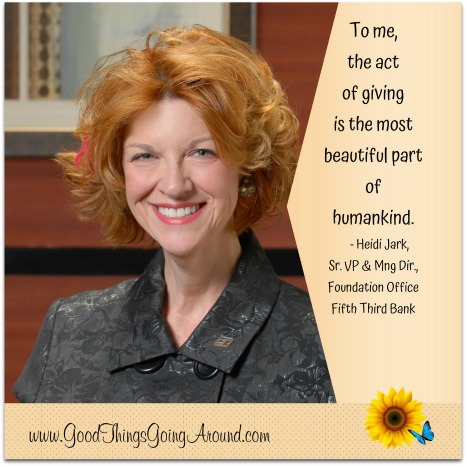 experiences. Growing up on a farm, and having been raised by loving, hard-working parents, gave her an early solid foundation. That, and a diagnosis of cancer at the young age of 19, gave Heidi a deep inner purpose and drive for building good and philanthropy. In her role at Fifth Third, she oversees investments from the bank’s own foundation, more than 20 other trustee foundations, and private family foundations. She and her husband, Steve Kenat, are active in the community. Among Heidi’s list of engagement, she has served on the United Way Leadership Cabinet, and is a past board member of the YWCA of Greater Cincinnati.
experiences. Growing up on a farm, and having been raised by loving, hard-working parents, gave her an early solid foundation. That, and a diagnosis of cancer at the young age of 19, gave Heidi a deep inner purpose and drive for building good and philanthropy. In her role at Fifth Third, she oversees investments from the bank’s own foundation, more than 20 other trustee foundations, and private family foundations. She and her husband, Steve Kenat, are active in the community. Among Heidi’s list of engagement, she has served on the United Way Leadership Cabinet, and is a past board member of the YWCA of Greater Cincinnati.
Please learn more about Heidi below.
GTGA: You grew up on a farm in South Dakota. How did your early experiences help to shape who you are today?
Heidi: Growing up on a farm definitely had an impact on the person that I am today. I didn’t necessarily appreciate or know the true impact until I was older, but those experiences have imprinted on several things in my life. First and foremost, it taught me the value of hard work and how work can bring great joy and be essential to your wellbeing. My Dad was always “working”, whether it was in the field, at his desk, or even doing carpentry in the winter months. He’s an amazingly happy person and takes great pride in his accomplishments, even today at the young age of 88. His greatest words of wisdom to me were to find something that I loved to do with my life and I would never do a day of work. Dad was definitely right about that! Secondly, working on the farm taught me the value of humor. That seems like an odd thing to say, but there was plenty to laugh about when things were good and when things went the wrong way. My parents had a great sense of humor and even work had its fun side. Whether it was gatherings via snowmobiles to the river bottom to ice skate and roast hot dogs on a moonlit winter’s night (one of my favorite memories) or impromptu family get togethers with tons of homemade food, laughter was always present in our lives. Farming wasn’t all about work. It was about community, spending quality time together, and having some of the best laughs I’ve ever had in my life. We had fabulous adventures on and off of the farm and it’s something I value and try to practice as much as I can. Finally, it taught me to appreciate the earth and all of its beauty. I still crave wide open spaces and look forward to those trips each year when I can get back to South Dakota, breathe the fresh air, and get my hands dirty.
GTGA: You were diagnosed with Hodgkin’s lymphoma. What are some life lessons learned from your experience?
Heidi: I was diagnosed a month before my 20th birthday and it was a shocker. You never want to hear the words, “you have cancer”, no matter the age. I was so fortunate to have made my way to Mayo Clinic in Rochester, Minnesota and to have parents who figured out a way for me to stay there for 4 months of treatment. I spent a lot of that time on my own, as it was planting season and my parents needed to be back home on the farm. I learned to be fiercely independent and to take charge of my health. I also learned to listen to my body and to let it rest when it needed a break. I also had time to think about who I was and who I wanted to be. I also learned that I can’t let fear of the unknown get the best of me or keep me from moving forward. I came out of the experience stronger and wiser than my years. I also made a list of the things I would do in my life if I got a second chance and it’s something I still try to follow every day. I didn’t know it at the time, but it’s great to get the midlife crisis out of the way much earlier than your friends.
GTGA: Who is someone who has impacted your life in a positive way and how?
Heidi: It’s hard to pick just one person, so I’m going to have to go with the 2 most important women in my life: my Mom and my oldest sister Becky. I was different from the other kids in our farming community, and my family recognized that at an early age. They embraced my differences and always made sure that I had support so that I could be whoever I wanted to be. My Mom was a school teacher and a very strong independent woman that you didn’t mess with, and she was my crusader and #1 supporter. Her words of wisdom live with me every day and I miss her terribly. We talked every day until her health deteriorated and she was unable to have a conversation with me. She’s in heaven looking over me now and I hear her voice in my head at least once every day. Becky is definitely like Mom and the two of us bear a striking resemblance to Mom in our looks, mannerisms, language, and even in our style of dress. She’s been my best friend and confidant for as long as I can remember. Becky lives out West and we only see each other a few times a year, but we talk on the telephone constantly. I know who to call if I need to laugh or cry.
GTGA: What are some of your simple pleasures in life?
Heidi: Reading, gardening, singing and playing the piano bring me great joy. I also love to cook and bake – that’s the farm girl in me coming out!
GTGA: When you think about the word ‘philanthropy’, what does that mean to you?
Heidi: Generosity always comes to mind when I think about philanthropy. The act of giving to me is the most beautiful part of humankind. When someone gives of their time or treasures, it’s truly a gift of heart and spirit. A farming community is one of the best places to learn the meaning of giving and how to care for each other. Little did I know that growing up on the farm would lead me to “work” that I love.
GTGA: What advice do you have to young people about living life?
Heidi: My advice is to live life to the fullest and to never have regrets. As a cancer survivor, every day is a good day because I’m alive. Even on the worst days, they are still better than the alternative. Dream big and surround yourself with positive people who can support you in the good times and the bad. Most of all, you need to believe in and take care of yourself. And, as my mother always reminded me, “If you’re going to kick some butt, make sure you wear some awesome shoes!”

Cincinnati Author Writes To Inspire
I just recently learned about one of Cincinnati’s hidden treasures…a very talented writer who brings others strength by sharing openly, vividly and passionately his own journey through deeply rooted personal challenges and experiences.
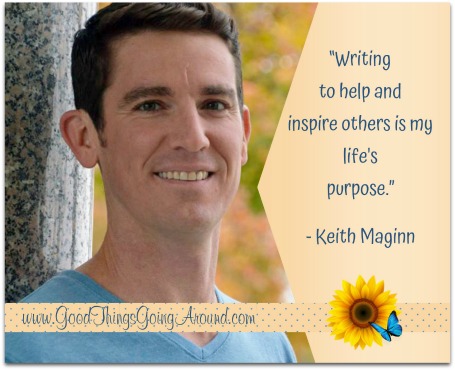 Keith Maginn was born and raised here. He moved to Knoxville, Tennessee just after college to work for AmeriCorps (a service organization like the Peace Corps, but within the United States) and for Knoxville Habitat for Humanity, but has since returned home and currently works for Kenton County Public Library in the Local History and Genealogy department.
Keith Maginn was born and raised here. He moved to Knoxville, Tennessee just after college to work for AmeriCorps (a service organization like the Peace Corps, but within the United States) and for Knoxville Habitat for Humanity, but has since returned home and currently works for Kenton County Public Library in the Local History and Genealogy department.
It was in December 2010, when he released Turning This Thing Around, a self-help memoir of overcoming personal struggles. Then, in January 2013, he self-published Goodwill Tour: Paying It Forward, detailing a 3,000-mile philanthropic pay-it-forward road trip through the southeastern United States. His most recent book, (Extra)Ordinary: Inspirational Stories of Everyday People, was just release in August, 2016 by KiCam Projects and tells seven inspirational stories of people he knows personally. (All three books are available in paperback and e-book on Amazon.com or at keithmaginn.com.)
“I feel writing to help and inspire others is my life’s purpose,” he told me.
Please read the rest of Keith’s story below:
I have been writing most of my life, as far back as I can remember. But it was never focused writing, just here and there. However, about seven years ago I 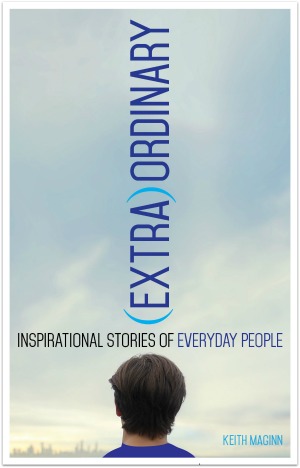 found myself sitting outside of a psych ward in Atlanta, Georgia. My then-fiancée was struggling terribly with bipolar depression. I had done everything I could, but was powerless to help her. I was also fighting my own battle with chronic pain, depression and anxiety. I had no idea what I could do to turn things around. No matter how hard I fought, how much I prayed, things seemed to get worse and worse.
found myself sitting outside of a psych ward in Atlanta, Georgia. My then-fiancée was struggling terribly with bipolar depression. I had done everything I could, but was powerless to help her. I was also fighting my own battle with chronic pain, depression and anxiety. I had no idea what I could do to turn things around. No matter how hard I fought, how much I prayed, things seemed to get worse and worse.
I soon found myself slipping into a deep depression, though I remained outwardly happy. Few of my family, friends or co-workers had any idea how desperate my predicament had become. My then-fiancée was adamant that no one know what she was going through, but I knew I couldn’t keep everything bottled up inside. I was perilously close to a complete nervous breakdown. Not wanting to betray her trust and talk to anyone, I started writing. It was my therapy, the only way to get some of the anger, sadness and confusion out of me. The story seemed to write itself. I realized that others might benefit from what I was writing. I felt people could relate to at least some of what I went through: heartbreak, depression, chronic pain, frustration…
When I started writing what eventually became Turning This Thing Around, I had no plans of ever publishing it. I wrote for myself, for my own sanity. But what started as a very personal diary evolved into something that I wanted to share with others. If I could overcome what I had, then others could, too. I decided to take a chance and self-published my writing as a “self-help memoir” (changing her name to protect her privacy).
I had no idea how people would react to my book. Would they think I was feeling sorry for myself and looking for pity? I had my doubts, but I am very glad I decided to go ahead with the project. The response was wonderful. I have gotten many replies from people that relate and then share their own stories with me. I am happy that people can learn from what I went through and that we can connect on a deeper level. I now know that people are often going through more than they show, making empathy, kindness and understanding all the more important.
(Extra)Ordinary: Inspirational Stories of Everyday People
After writing my first two books, which were about my life and experiences, I started thinking about all of the people that I know that have amazing stories. These individuals had overcome major obstacles, but they aren’t celebrities, so no one really knew what they had been through, how they had endured in tough circumstances. I wanted to tell their stories and to point out that everyone goes through hardship; these people rose above their challenges and can serve as inspiration to others.
When I was writing my book about inspirational people I know, one theme that appeared several times was the depth of a mother’s love. I guess this was something I took for granted in the past, but seeing so many emotional, awe-inspiring examples in black-and-white really opened up my eyes. I learned that there is nothing like the power of the love mothers have for their children.
I recently signed with KiCam Projects to write the second volume of (Extra)Ordinary. My fourth book is scheduled for release in fall of 2017.
Penguins Are His Passion
When Ric Urban walks into the area of Newport Aquarium where the African Penguins are housed, they all waddle over to him…especially one little girl, Paula. It is yet one more reason why this man who has been doing his work (Newport Aquarium is his fifth employer) for 35 years has no plans for retiring. He loves what he does. It is his passion and his purpose.
“With the birds at the Aquarium, I have been able to promote penguin conservation to a whole new level. When people see and meet a penguin, they are making a connection that will hopefully empower them to do something,” he said.
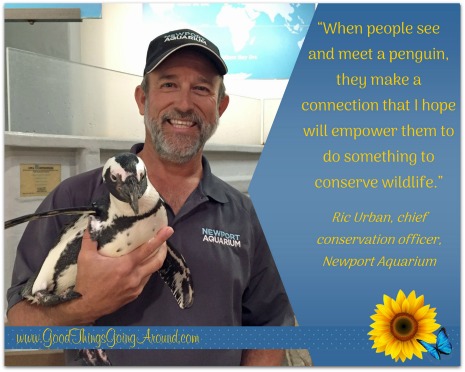 As the Aquarium’s Chief Conservation Officer, Ric’s job is about promoting the mission of conversation in our community…and around the globe. He wants visitors of Northern Kentucky’s destination favorite to be enthralled while they are there, and leave with information to become interested and engaged in saving wildlife and the ecosystem beginning in their back yards.
As the Aquarium’s Chief Conservation Officer, Ric’s job is about promoting the mission of conversation in our community…and around the globe. He wants visitors of Northern Kentucky’s destination favorite to be enthralled while they are there, and leave with information to become interested and engaged in saving wildlife and the ecosystem beginning in their back yards.
However his job entails so much more. On any given day, he could be testing water, speaking to groups, teaching classes, creating programs, or traveling the globe. He has participated in many research projects through his career. This past spring he was appointed by the Association of Zoos and Aquariums (AZA) to be the program coordinator for the AZA SAFE African Penguin Identification Project. The goal of the Project has been to tag at least 10% of the world’s declining population of African Penguins over the next 3 years. That’s around 5,000 birds to be tagged and identified in South African and Namibia. It is an especially important program as African Penguins were placed on the endangered species list in 2010. The Newport Aquarium is one of 50 AZA-accredited zoos and aquariums that house these birds, and Ric did the original hand feeding of all eight that are on display in Northern Kentucky. Paula is often their ambassador, traveling with Ric on appearances to local events. I actually met Paula and Ric for the first time at a Muscular Dystrophy fundraiser.
When I asked Ric about his most interesting journey, he brought up the 2012 research project in Peru to learn about the Humoldt Penguin. They were working to prevent the decline in population of these birds, just as what has happened with the African Penguin. Guano, the fecal matter produced by sea birds, is a very effective and natural fertilizer, and of great value for the harvesters. The problem is that, being a natural pesticide, also makes guano an excellent place for Humoldt Penguins to lay eggs, and when the guano is harvested it has the potential for great harm to the Humoldt Penguin population. Ric was an observer. He was in South America to make sure the nests were undisturbed during harvesting. The whole experience was one he will never forget.
He shared this story.
“It was exciting to see wild Humoldt Penguins for the first time and go out with Peruvian biologists to watch what they are doing to save and protect the species, and preserve the ecosystems. Peru is one of the largest reserves for that penguin.
We were definitely roughing it. There was only power for three hours in the evening and no refrigeration. For toilets we had to use bail water from the ocean. We had male and female sides of the bathrooms, and would do bucket brigades every few days to fill the needed supply. We had to walk to the headquarters, about two miles away and across a coastal desert, to get a few minutes of shower time.
One night after our day was through, a young biologist invited me to explore. We wandered down into this area where the coastline had fallen onto the beach and created a long cave. The biologist had seen birds go there and then disappeared, and decided to follow them one day. That night he told me to crawl under a rock, and then we went on this incline that must have been 20 to 30 feet. You could feel the bottom of the cave below your belly and the space was so small that you couldn’t raise your neck. Then we got to the top and there must have been dozens of birds sitting on nests.
It was incredible. No where have I ever read about penguins nesting in the darkness of caves. It took everything I had ever learned and added a whole new level.”
With stories like that, it is no wonder why Ric has no immediate plans for retirement.
